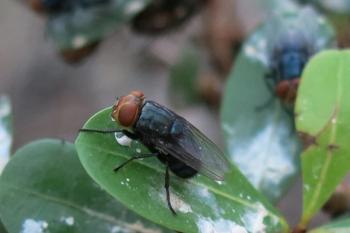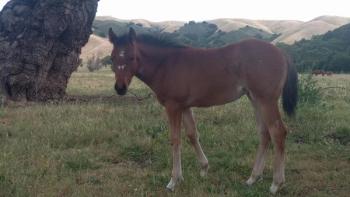
Fooling mother nature: DVMs being asked to control strong heats
The weather is slowly getting warmer and that means that two of an equine veterinarian's busiest seasons are soon to be here - breeding and showing. Unfortunately these two activities do not go together well for some mares.
The weather is slowly getting warmer and that means that two of an equine veterinarian's busiest seasons are soon to be here - breeding and showing. Unfortunately these two activities do not go together well for some mares.
The physiological changes that occur in the spring as mares come intoestrus and begin cycling in earnest often conflict with a busy trainingand show schedule. Veterinarians are being asked more frequently to assistin controlling what the owner and trainer feel are excessively strong heatcycles in some mares.
Control the cycle
Typically these horses are normally well behaved when not in season.Mares that are generally strong willed or slightly aggressive and difficultto deal with normally may become even more so during heat. When mares beginto cycle, they can become very vocal, calling to other horses constantly.
They may stop to "flag" (raising and averting the tail) andurinate excessively. Some mares will kick at a stall wall or repeatedlybump the walls with a side or flank. When being ridden, these horses canvary from slightly resistant to leg pressure and unfocused to being totallyreluctant to respond to rider aids and acting aggressively - bucking, kickingand/or biting.
None of these behaviors is consistent with pleasurable riding or successin the show ring, so veterinary help is being sought to keep these marescalm and often, to prevent or delay normal estrus behavior.
Suppress estus
The most effective method of manipulating a mare's cycle to keep herfrom showing estrus is to maintain the corpus luteum (CL) as the mare wouldnormally do in a pregnant state. This ovarian structure would produce endogenousprogesterone at a level sufficient to suppress estrus for a period of roughly150 days.
There are various sources and forms of progesterone available to thepractitioner for this purpose. Not all of these products, however, are labeledfor use in the horse and some have not shown any evidence of efficacy.
The most traditional method of estrus suppression is through the useof daily oral administration of a synthetic progestin (Regumate-alternogest).This method works well for most mares and, if the animals are taken offthe drug and given a sufficient amount of time for the system to normalizepost long-term use, these mares will return to normal cyclical activityand normal reproductive function.
The disadvantages with daily oral use relate to the difficulty of gettingthe drug in some mares with ease and confidence and the fact that this productcan be absorbed through human skin and can adversely affect human hormoneactivity.
Injections
Intramuscular injections of progesterone are also currently availablewith the dosage and periodicity dependent on the type of formation usedand its concentration.
Daily injections are often not well tolerated by the animal, especiallywhen we consider that these mares are usually harder to handle and dealwith than most mares. Since these injectable preparations, especially theones designed to be given at weekly or longer intervals, are commonly preparedin a slowly dissolving oil they can cause soreness at the injection siteand, over time, have been associated with firm nodules or lumps of fibroustissue at the injection sites.
Again, this is unacceptable in sport horses since the resultant neckstiffness can be even more detrimental to performance than the initial estralbehavior. Injectable depo-provera is a more recent product that has, asan advantage, a minimally reactive formulation and a dose interval for mostmares of 60 to 90 days. Effectiveness can be variable though.
Some owners and trainers, however, have horses that do not respond tothese drugs or they may be reluctant to use hormone therapy in their horses.A relatively new approach may be beneficial for these cases.
Mimic embryonic development
Drs. Nie, Johnson, Braden and Wenzel, from the College of VeterinaryMedicine at Auburn University are responsible for research presented ina paper at the 2001 American Association of Equine Practitioners meetingin San Diego. Their research focused on the use of a glass ball insertedinto the uterus of a mare in order to suppress estrus.
This relatively simple idea has caught on and has been working well fora number of practitioners throughout the country.
Nie, speaking on behalf of his research group, said that the exact mechanismas to how and why this approach works is unclear at this time. It is postulatedthat the glass ball mimics an early developing embryo and sends the sametactile stimulus to the uterine lining which, in turn, encourages maintenanceof the CL. Nie's study showed that five of 12 mares (41.7 percent) had aprolongation of luteal function and these mares did not cycle for 76, 78,86, 95 and 109 days respectively.
The other seven mares in this study cycled back in an average of 20 days.Other practitioners who have since tried this approach are reporting slightlybetter results with some listing success rates as high as 67 percent. Inthe mares where this glass ball implant works estrus has been suppressedfor an average of three to four months.
Clearly there are individual differences and some, as to yet undeterminedreasons, for the high success with some mares and the failure with others.It may be likely that internal uterine conditions, uterine-ovarian hormonalinteraction or a combination of both may be the factors that affect theoutcome.
Safe procedure
The actual procedure is relatively easy to accomplish and is safe. Nocomplications from the placement of these glass balls have been noted andthis has been confirmed through ultrasound and histological testing.
The mare should be prepared as for artificial insemination and attentionto cleanliness is important since the primary concern is that these implantsmay be a source of infection.
The glass balls themselves can be obtained from any number of places.Glass Ball Studios in Oregon (www.glassmarble.com/MareMarbles.html) producesa dazzling array of what are really collector grade marbles.
Some practitioners have found marbles at antique stores and one veterinarianreports good results with marbles purchased at his local Toys-R-Us. Somepractitioners have used silicon eye prosthetics available from Jardan EyeProstheticsInc. of Southfield, Mich. All of these products should be autoclaved andNie recommends using the autoclave cycle recommended for fluid, as the long,slow cool down in this particular cycle will avoid breaking the glass balls.
The size of the ball is important, and a 35-mm diameter ball seems optimal.After adequate preparation, a sterile palpation sleeve is used and the glassball is passed vaginally through the cervical lumen and into the uterinebody. The glass ball can then be manipulated via rectal palpation and movedfurther into the uterine body.
Correct placement of the ball at the horn-body junction can be easilyconfirmed with an ultrasound examination.
Some practitioners follow placement of the ball with infusion of antibiotic(ticarcillin at 1 gram is recommended by Nie) to help with any possibleinfection. Correct sterile technique will lessen the need for such usehowever.
The ball should be placed within 24 hours of ovulation. Some veterinarianshave reported that certain mares will spontaneously expel the balls, butthis is uncommon and was not observed in any of the mares in Nie's study.
The tag line from a 1980s advertising slogan was "It's not niceto fool Mother Nature." Perhaps, in this case, an exception can bemade. The use of glass balls to suppress estrus provides the practitionerwith a safe, simple method of keeping some mares out of heat.
This method does not have any significant disadvantages for immediateperformance use or for long-term reproductive use. It does not require extra-labeldrug use and it offers the owner a more "natural" means of controllinga potentially difficult mare. So before you lose your marbles dealing withthat "witchy" sporthorse, consider putting one in.
Newsletter
From exam room tips to practice management insights, get trusted veterinary news delivered straight to your inbox—subscribe to dvm360.






